DRIVING BUGS
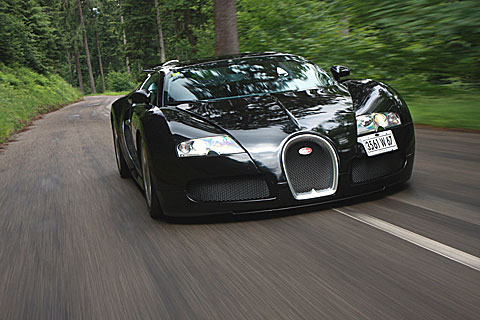
The Veyron, above is a modern interpretation of a pur sang Bugatti. The EB 110 below, while a brilliant engineering exercise, is not; all that went into Artioli’s factory.
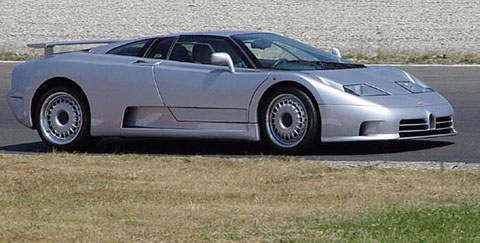
EB 110
An Italian Interpretation
It’s clean and comfortable in here. The engine idles so smoothly it’s hard to know if you need the clutch to get into first. The seats are more Bentley than Bugatti, in fact, the dash is burl walnut not razor-edged, retro racer. In an effort to make the world’s fastest and most expensive commuter the “exotic” element has simply been eliminated.
The term supercar was created for the Countach, Lamborghini made it exotic. From across town came the Testarossa, unmistakably Ferrari, but Romano Artioli’s supercar was friendly, almost familiar. It was created to be the ultimate supercar. It would pass 200 mph, go from standing to 60 mph in 4.4 seconds, had full-time all-wheel drive and its 60-degree, 3.5-liter V12 used DOHC to operate five valves in each cylinder and four IHI turbochargers to produce 550 hp.
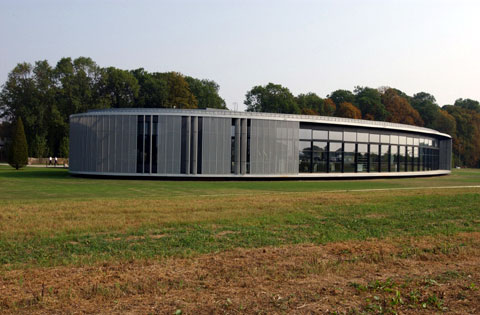
Artioli’s assembly plant is an impassioned tribute to Bugatti iconography, in color and form and detail.
Romano Artioli, Bugattiste and Italian entrepreneur extraordinaire (assuming a French accent) built a white tile-lined gallery that looked more like an art museum of Bugatti iconography than a car factory. And every piece assembled there was a handcrafted jewel. The engine/gearbox casting would bring tears to Le Patron Bugatti.
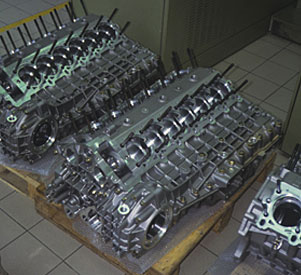
The Bugattis would have loved the EB 110
drive train. The gearbox is beside the
crankcase, all in a single casting. Absolutely
beautiful.
It was not a simple milled rectangle as he decreed, instead it was an entire, complex surface of rectangular ribbed structure. Marcello Gandini was asked to draw Artioli’s dramatic, scientifically effective, aerodynamic vision; Jean Bugatti’s brilliant details from the classic era were summarily dismissed with the exception of a Bugatti-radiator-shaped hole in the nose that looks like it was designed as a place to insert your travel umbrella. Only the name, badge and the few Galloise-pack colored examples even suggest Alsacian heritage. The name is pur sang (pure blood, thoroughbred), EB 110 is Ettore Bugatti’s initials (which also appear all over the building) and the years from his birth until the date of the supercar’s introduction, 15 September 1991.
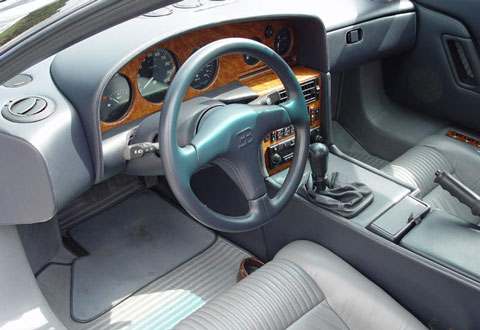
An EB 110 from inside is the Honda Prelude of supercars. All the excitement is behind you and virtually imperceptible, except for the blur of telephone poles streaming by.
Does it work? Perfectly. No! I mean it works perfectly! In one experienced exotic-car-pilot’s opinion, the EB110 is overly engineered. The dynamics are brilliant; steering sharp, gear change light, the cockpit spacious, the climate and sound selection Honda-like. Wait! That’s a problem. Driving quickly feels like you’re driving the world’s fastest Prelude. It is the perfect luxury commuter –until asked to perform, at which time it rushes to multiply the posted limit in ever-larger increments so quickly one could be excused for getting behind. The rush is delivered with a rising hum of 12 isolated cylinders exhaling through four carefully silenced turbochargers.
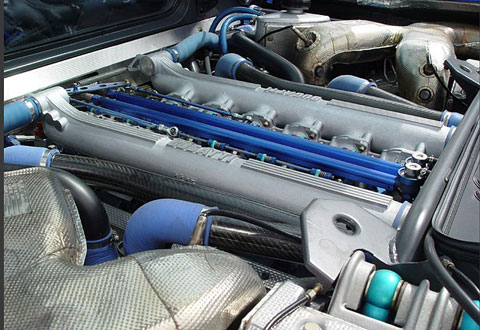
The EB110 power source makes a good case for a Lucite body so you can see all of it.
Like every other thoughtful consideration, unless you were Ayrton Senna and right up against its incredibly high limits, it gives you nothing for having been there. The terror of an Italian exotic approaching its limit is simply precluded by 4-wheel traction, massive negative lift aerodynamics and quiet. If we overlook the international financial situation at the time, from which the customers for a half-million-dollar toy were insulated, that is why it failed. Where’s the grief? The world’s fastest Prelude generates all the impressive dynamics numbers, but not the heart rate. Hundreds of exotic car buyers could not have cared less.
VEYRON
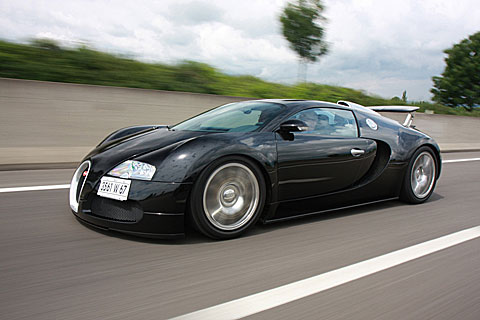
The Veyron is no less a useful, luxurious commuter, but it is also profoundly exotic and exciting, from the silence of a dark garage or a sunny blast at peak revs.
Authentic to the ground
Leave it to Volkswagen to “get it” — Bugatti cars were German (pre-1919 armistice they raced in white livery) before they were French, after all. Then name it after a courageous privateer racer with real credentials you have never seen.
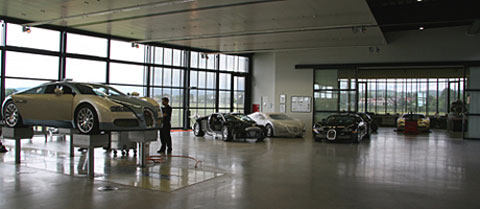
The Volkswagen team plotted a giant Bugatti badge on the original property and built a glass atelier as an assembly plant.
They put their construction “atelier” on the Bugatti property and the offices in the chateau. The drawing is a pure modern interpretation of what Jean Bugatti would be thinking now. They simply did everything right. And the Bugatti Veyron is perfect. NO! WAIT! Superb is probably more accurate.
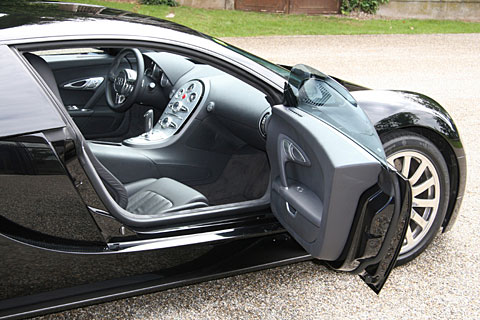
If a Veyron invitation does not raise your heart rate — you’re dead.
There is no terror in it, but all the tactile functions in the cockpit require the driver’s presence and attention and feel substantial in the effort. And the sound is no-kidding exotic–not loud–not obtrusive or belligerent, just present and important. The Veyron is no less useful a commuter than the EB 110 but when you get there you will be absolutely sure you did it in a fabulously exotic machine.

Thoroughbred muscle.
If you want to play in the canyons on the way home –do it. You’ll love it. And it will do no wrong. It accelerates like a super bike and brakes and turns like a Lotus–the all-inclusive tire patch is the size of a small county. It can be a million-dollar plaything-on demand, even by request. Press down, push down, or stomp and the Veyron will deliver, immediately, what your right foot has suggested. We got into 160 in traffic in a few seconds and back to 80 in half that. A ton (100 mph) is a quiet cruise. One might consider a second home in some civilized country with tolerance and space.
The engineering is no less than the EB110, but a visceral character is permitted access to the cockpit. Sixteen DOHC cylinders, each a half-liter, pressure-fed by four turbochargers produce over 1000 hp and it is clear at idle.
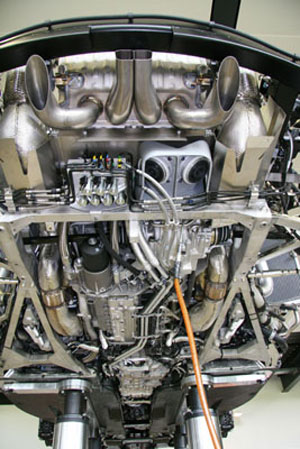
In its own way, the underside
demonstrates the beauty of
the Veryon as surely as the body.
As you ask more its voice changes — from a rumble to a roar to a primal howl you will not soon forget. It is repeated through the seven-speeds in the gearbox. You will have tripled the 60 mph limit at the top of fourth with three to go, 250+ mph is a documented top speed. The complex steering system does nothing to isolate you from the grip of the right front tire, but the hole in the pavement is barely felt. A manual gear lever is available, but why? I am the worst Luddite in this area, but current paddle shifters and double clutches with computer-matched revs make the iron bar in the aluminum gate seem painfully slow. Everything is the cockpit illustrates hand-crafted Bugattiness. The brochure describes the functional elements, “Not a switch too many, not a switch too few…” The cockpit is a tangible, visible, livable working space for the most exciting sports car of its time. At $1.4-million per copy, there is more than a year’s wait for the eight cars completed each month. And the Veyron passes the ultimate test. It is impossible to get out and walk away without looking back to grin.
Congratulations for the above article, cleverly written and very interesting to read. However I disagree strongly with the theory of a Veyron with “Bugatti blood” versus a “non-Bugatti-blood” EB110…
I feel that facts tell a slightly different story.
First of all the origins of the Artioli-Bugatti are linked to Ferruccio Lamborghini himself and to Paolo Stanzani, as the latter explained to me personnally : Ferruccio, after having left his factory (and sold all his shares), started discussing with Stanzani, also dreaming of creating another super exotic car, continuing -and going beyond – the Miura and Countach breed. It’s their sheer passion for cars that fired the project of a “super-super car”…
Stanzani agreed then with Artioli – who would provide the funds – to work for him and to design the car, whilst Ferruccio, when he knew that the name Bugatti would be used, left the project.
Now the result of Stanzani’s genius was a true leading-edge technolgy car and even revolutionnary – especially for its time !
With permanent 4-wheel drive, a gearbox integrated and parrallel to the engine block, a full carbon-fiber chassis, a rear ground-effect diffuser, 5 valves per cylinder, and 4 turbos (two small, two big for better response), a foldable rear wing …this was a daring and very exciting car that Le Patron would probably have loved. The very complex active suspension project – abandonned at the end – was also a typical Bugatti-like ambitious concept for a road GT.
Furthermore, the company was an independant one, attempting to create beauty and innovation in more than one field (like architecture as you said), whith in-house designers and engineers, not driven by marketing plans, but by passion and an ambition to do, by themselves, the best sports car ever, light, fast, but also “racée”, with a shape never seen before.
In comparison, Audi-VW had a pure marketing plan, that is to boost their range of brands from VW to Audi, to Bentley by making an ultra-visible media product, with – typically marketing-dictated – striking figures like 1000 BHP and 400 km/h.
The car itself is certainly powerful (as anyone can do with turbos as demonstrated by the multitude of 1000 BHP+ cars), but very, very heavy – and this is a considerable handicap for tight curves, not to mention polar intertia.
In addition, it is reported that the car suffers from several problems, from electronic failures to severe overheating, due to a concentration of systems in a very tight volume.
Furthermore, the Veyron borrowed a lot to existing suspercars : multiple turbos like the EB110, 4-wheel drive like the Diablo and EB110, folding wing, again like the EB110…
The design itself is, for many, rather unsuccessful, original but lacking grace and elegance.
Another disputable aspect of the Veyron – in itself a very impressive one I admit – is probably the cynical search by AUDI-VW for Bugatti “clues” and marketing tricks : buying the Château, F. Piech wearing a cap looking like Ettore’s, heavily hammering that the car “is” a Bugatti and deeply rooted in the Molsheim soil..all this maks me feel uncomfortable, like realising that I’m buying a fake, and reading clearly the manipulation in each word of the seller.
All in all, none of the two cars is a true Bugatti. As an old Bugatti enthusiast told me “the DNA was lost, after Jean and Ettore’s death”. However, the EB110 is, in my opinion, more a car created by real people with real feelings and passion, whereas the Veyron sounds and feels like a marketing “product” designed to be a media hit. In this sense, the EB110 – especially the lighter, more popwerful SS version – is much closer to the real thing.
The EB 110 was an exceptional Pur Sang developped by brilliant enthousiasts without a lot of means. Ettore would have liked it!
The Veyron is a car manufacturer technical window. Fantastic car, but maybe not in the same Pur Sang tradition, eventhough no efforts have been spared.
I have bookmarked https://velocetoday.com/archives/2699 at reddit.com so my friends can read it too. I simply used A Car Life, by Larry Crane as the link title in my bookmark, as I figured it would be a good way to promote this awesome post. Email me back at Sentinella4537@gmail.com if there is anything else I can do to help.